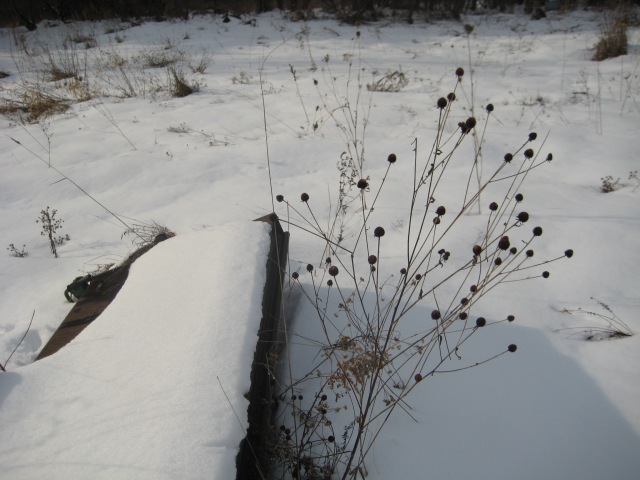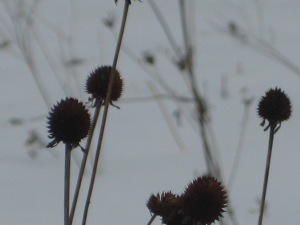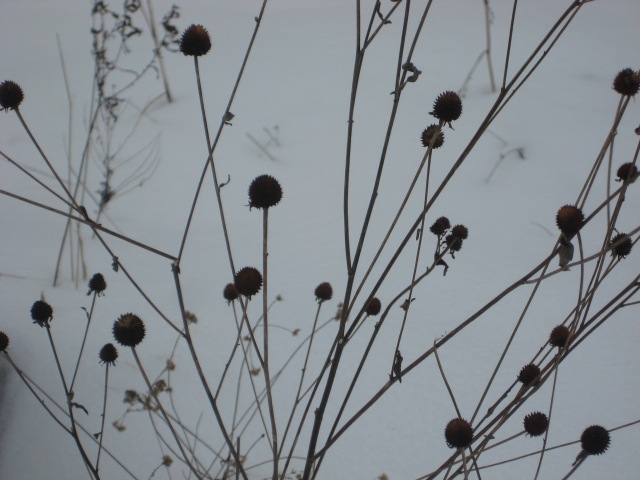A cold and dre ary winter field. In summer it’s a green and golden wildflower meadow. In winter it’s brown stalks.
ary winter field. In summer it’s a green and golden wildflower meadow. In winter it’s brown stalks.
Peeking out from under this abandoned piece of haying equipment (I think it’s a baler?) is a not-very-well-known wildflower. In summer it looks a lot like a daisy, but with golden-yellow rays surrounding a dark “eye” center. Nope, not a Black-eyed Susan.
In summer it looks a lot like a daisy, but with golden-yellow rays surrounding a dark “eye” center. Nope, not a Black-eyed Susan.
This is one of Susan’s cousins, though, in the Rudbeckia family. Three-Lobed Coneflower, or Thin-Leaved Coneflower, or Three-Leaved Coneflower, depending on which field guide you use. Coneflower describes this plant pretty well, since a thimble-shaped cone filled with seeds forms the center of the flower head. It’s a native plant, unlike most meadow sun-lovers.
But it’s not a Black-eyed Susan, although they resemble each other, and sometimes the coneflower is called Brown-Eyed Susan, which really confuses the issue. It’s that common name thing again–you say to-MAY-to and I say to-MAH-to. Plants, especially wildflowers, have so many common names it’s hard to tell which is which.
Of course, like all living things (or at least all living things that have been noticed by science) this little plant has a Latin name. Once we mention the Latin name, all doubt is removed as to which species we’re discussing. Rudbeckia triloba. Triloba is for the three-parted (or lobed) leaves. And Rudbeckia is a memory of a friend.
Linnaeus, the great Swedish naturalist of the eighteenth century, was the first to come up with the idea of using two Latin names to describe living things. His goal was to remove the confusion felt (still) by botanists when they try to pin down identification using English (or French, or Swedish, or Chinese) common names.
Plants being the major source of medicine in past centuries, it was important to really know which plant you were talking about. Imagine going into the drugstore to get medicine for a cold and not being sure what the name of the medicine was (“I need some aspirin…or was it antacid…or maybe arsenic?”) One type of medicinal plant, a rose widely used to treat dog bites, was called by one textbook Rosa sylvestris inodora seu canina. while another called it Rosa sylvestris alba cum rubore, folio glabro. Some plants had names that were so long no one could remember them. The Latin name for a tomato was Solanum caule inermi herbaceo, foliis pinnatis incises racemis simplicibus.
Linnaeus changed all that. He gave each plant two, and only two, descriptive names. Short. Easy to remember. He labelled the aforementioned rose Rosa canina.
 Just for fun, he often named plants after his friends and colleagues. He named a family of beautiful golden flowers Rudbeckia, after his favorite teacher, Olaf Rudbeck. “So long as the earth shall survive, and each spring shall see it covered with flowers, the Rudbeckia will preserve your glorious name,” he wrote to his friend.
Just for fun, he often named plants after his friends and colleagues. He named a family of beautiful golden flowers Rudbeckia, after his favorite teacher, Olaf Rudbeck. “So long as the earth shall survive, and each spring shall see it covered with flowers, the Rudbeckia will preserve your glorious name,” he wrote to his friend.
Linnaeus named tens of thousands of species, often naming beautiful plants after friends and people he admired. A fellow botanist named Johannes Siegesbeck strenuously disagreed with Linnaeus’s shocking method of using sexual terms like “ovary” and “sperm” to describe plant parts. Linnaeus and Siegesbeck argued bitterly for years, but Linnaeus had the last word—he named an ugly, creeping, bad-smelling weed Siegesbeckia.
Linnaeus was quite a character. He’s a favorite of mine. Botanists tend to be quiet types, not flamboyant and dramatic impresarios, but botanizing with Linnaeus was anything but dull. He was a famous and well-loved teacher, lecturing to standing-room-only audiences. (Maybe there just wasn’t that much else to do in eighteenth-century Sweden.)
As all good teachers do, he got the kids out of the classroom and took them on field trips. But his field trips might have two or three hundred students, and last for twelve hours. The enthusiastic botanists carried flags and banners, and even brought musical instruments: kettledrums and bugles. Whenever someone found an unusual plant, Linnaeus would hurry over and get down on his hands and knees to examine it. If the plant was a rare specimen, he would shout for the bugles to sound.
You have to love a botanist with an ego as big as a rock star. In his will, Linnaeus left instructions that his tombstone should bear the Latin name he bestowed on himself: Botanicorum principi, Prince of Botanists.
But my favorite Linnaeus story is when he from when he was a youngster, just starting out, enthralled with the beauty and mystery of plants.  He made a solitary expedition to Lapland, and discovered a fragrant pink wildflower with twin blossoms and shiny evergreen leaves. He said the smell of the flowers was so sweet that it reminded him of candy. He named the little plant after, of course, himself: Linnea borealis. (Borealis meaning “in the north.”)
He made a solitary expedition to Lapland, and discovered a fragrant pink wildflower with twin blossoms and shiny evergreen leaves. He said the smell of the flowers was so sweet that it reminded him of candy. He named the little plant after, of course, himself: Linnea borealis. (Borealis meaning “in the north.”)
But many years later he described his namesake as “A plant of Lapland, lowly, insignificant, disregarded, flowering but for a brief space.” He added that it was named after “Linnaeus, who resembles it.”







Great stories! Had no idea Linnaeus had such a delicious sense of humor!